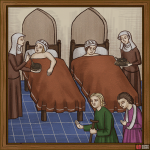Text
Since ancient times, people have been educated in medicine and have tried to help others in the fight against illness and pain. The oldest texts of medical practices have been preserved in monasteries, which were the first centres of medieval medicine. Medicine was primarily practised by Benedictines. Unlike city doctors, they did not charge money for their care.
In the 11th century, hospitals experienced significant development, mainly thanks to knightly orders dedicated to charity, and the construction of hospitals or shelters for travellers. Care for the sick was entrusted exclusively to men; women and nuns were forbidden to assist in hospitals by the Church Council.
Treatment of wounds was most often carried out by disinfecting with hot iron, water, or applying various ointments or balms to the wound. Bandaging was done with cloth or linen. Herbs were applied to open wounds and inflammations. Soldiers often had to be able to help themselves because field hospitals could not move quickly enough with the military camp. The wounded often did not survive the several-day journey in an open cart.


No Comments